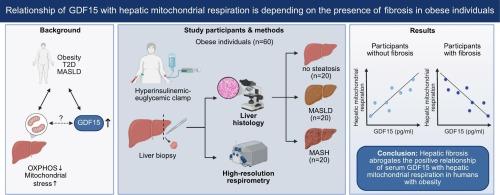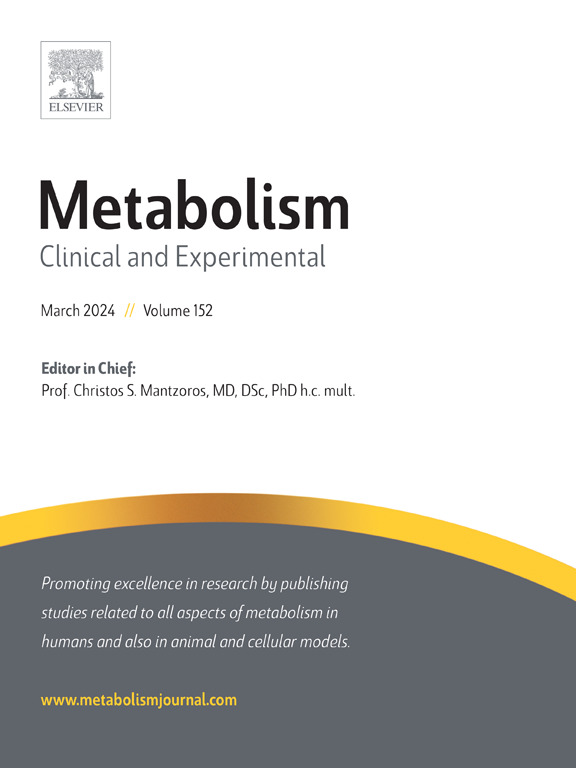GDF15与肝脏线粒体呼吸的关系取决于肥胖个体中纤维化的存在。
IF 11.9
1区 医学
Q1 ENDOCRINOLOGY & METABOLISM
引用次数: 0
摘要
背景和目的:临床前研究报道,当线粒体功能降低时,生长分化因子15 (GDF15)升高。在人类中,代谢功能障碍相关的脂肪性肝病(MASLD)和脂肪性肝炎(MASH)表现出不同的肝脏线粒体适应。我们假设在肥胖和/或MASLD/MASH中,循环GDF15与肝脏线粒体呼吸有不同的相关性。方法:没有(n = 20)和活检证实MASLD (n = 20)或MASH (n = 20)的人接受高胰岛素-正血糖钳夹,评估全身(m值)和脂肪组织(胰岛素诱导的NEFA抑制)胰岛素敏感性。ELISA法测定空腹血清GDF15和胰高血糖素含量。通过高分辨率呼吸计测量减肥手术中肝脏的线粒体呼吸。用Spearman非参数相关法评估相关性。结果:在整个队列中,血清GDF15与m值(r = -0.35,p = 0.017)和NEFA抑制(r = -0.29,p = 0.046)呈负相关,但与肝脏线粒体呼吸无关。然而,相关性被发现在分层分组基于存在(n = 37岁的年龄:41 ± 2 y, BMI: 49 ±1 kg / m2)或缺乏肝纤维化(n = 23日,44 ±2 年,BMI: 49 ±1 kg / m2)。在无纤维化的人群中,GDF15与脂肪酸氧化相关(FP; r = 0.35,p = 0.035)和最大耦合(FNSP; r = 0.42,p = 0.010)线粒体呼吸呈正相关。相反,在纤维化患者中,GDF15与肝脏FNP呈负相关(r = -0.48,p = 0.022)。结论:在肥胖人群中,血清GDF15与无肥胖人群的肝脏线粒体呼吸呈正相关,而与肝纤维化人群呈负相关。未来的研究需要调查GDF15是否以及如何以纤维化依赖的方式影响肝脏线粒体呼吸和/或相反,纤维化如何通过改变线粒体功能调节肝脏GDF15分泌。本文章由计算机程序翻译,如有差异,请以英文原文为准。

Relationship of GDF15 with hepatic mitochondrial respiration is depending on the presence of fibrosis in obese individuals
Background and purpose
Preclinical studies reported elevated growth differentiation factor 15 (GDF15) when mitochondrial function is reduced. In humans, metabolic dysfunction-associated steatotic liver disease (MASLD) and steatohepatitis (MASH) exhibit different hepatic mitochondrial adaptation. We hypothesized that circulating GDF15 differently correlates with hepatic mitochondrial respiration in obesity and/or MASLD/MASH.
Methods
Humans without (n = 20) and with biopsy-confirmed MASLD (n = 20) or MASH (n = 20) underwent hyperinsulinemic-euglycemic clamps to assess whole-body (M-value) and adipose-tissue (insulin-induced NEFA suppression) insulin sensitivity. Fasting serum GDF15 and glucagon were quantified by ELISA. Mitochondrial respiration was measured in liver obtained during bariatric surgery by high-resolution respirometry. Associations were assessed with Spearman's nonparametric correlation.
Results
Serum GDF15 correlated negatively with M-value (r = −0.35, p = 0.017) and NEFA suppression (r = −0.29, p = 0.046), but not with hepatic mitochondrial respiration across the whole cohort. However, correlations were found upon stratification into groups based on the presence (n = 37, age: 41 ± 2y, BMI: 49 ± 1 kg/m2) or absence of hepatic fibrosis (n = 23, 44 ± 2 years, BMI: 49 ± 1 kg/m2). In persons without fibrosis, GDF15 correlated positively with fatty acid oxidation-linked (FP; r = 0.35, p = 0.035) and maximal coupled (FNSP; r = 0.42, p = 0.010) mitochondrial respiration. Conversely, GDF15 correlated negatively with hepatic FNP in persons with fibrosis (r = −0.48, p = 0.022).
Conclusions
In humans with obesity, serum GDF15 correlates positively with hepatic mitochondrial respiration in persons without, but negatively in persons with hepatic fibrosis. Future studies are needed to investigate whether and how GDF15 affects hepatic mitochondrial respiration in a fibrosis-dependent manner and/or, conversely, how fibrosis might modulate hepatic GDF15 secretion through altered mitochondrial function.
求助全文
通过发布文献求助,成功后即可免费获取论文全文。
去求助
来源期刊

Metabolism: clinical and experimental
医学-内分泌学与代谢
CiteScore
18.90
自引率
3.10%
发文量
310
审稿时长
16 days
期刊介绍:
Metabolism upholds research excellence by disseminating high-quality original research, reviews, editorials, and commentaries covering all facets of human metabolism.
Consideration for publication in Metabolism extends to studies in humans, animal, and cellular models, with a particular emphasis on work demonstrating strong translational potential.
The journal addresses a range of topics, including:
- Energy Expenditure and Obesity
- Metabolic Syndrome, Prediabetes, and Diabetes
- Nutrition, Exercise, and the Environment
- Genetics and Genomics, Proteomics, and Metabolomics
- Carbohydrate, Lipid, and Protein Metabolism
- Endocrinology and Hypertension
- Mineral and Bone Metabolism
- Cardiovascular Diseases and Malignancies
- Inflammation in metabolism and immunometabolism
 求助内容:
求助内容: 应助结果提醒方式:
应助结果提醒方式:


